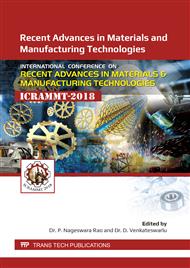[1]
W. Chen, Z. Fu, S. Fang, H. Xiao, and D. Zhu, Alloying behavior , microstructure and mechanical properties,, J. Mater., vol. 51, p.854–860, (2013).
DOI: 10.1016/j.matdes.2013.04.061
Google Scholar
[2]
S. Ranganathan, Alloyed pleasures : Multimetallic cocktails,, vol. 85, no. 10, p.10–12, (2003).
Google Scholar
[3]
S. Guo, C. Ng, J. Lu, C. T. Liu, M. Carlo, S. Guo, C. Ng, J. Lu, and C. T. Liu, Effect of valence electron concentration on stability of fcc or bcc phase in high entropy alloys Effect of valence electron concentration on stability of fcc or bcc phase in high entropy alloys,, vol. 103505, (2011).
DOI: 10.1063/1.3587228
Google Scholar
[4]
S. J. Mary, R. Nagalakshmi, and R. Epshiba, HIGH ENTROPY ALLOYS PROPERTIES AND ITS APPLICATIONS – AN OVERVIEW,, vol. 4, no. 6, p.279–284, (2015).
Google Scholar
[5]
G. R. Holcomb, J. Tylczak, and C. Carney, Oxidation of CoCrFeMnNi High Entropy Alloys,, vol. 67, no. 10, p.2326–2339, (2015).
DOI: 10.1007/s11837-015-1517-2
Google Scholar
[6]
V. F. Bashev and O. I. Kushnerov, Structure and Properties of High Entropy CoCrCuFeNiSn x Alloys,, vol. 115, no. 7, p.737–741, (2014).
Google Scholar
[7]
X. Yang and Y. Zhang, Prediction of high-entropy stabilized solid-solution in multi-component alloys,, Mater. Chem. Phys., vol. 132, no. 2–3, p.233–238, (2012).
DOI: 10.1016/j.matchemphys.2011.11.021
Google Scholar
[8]
Z. Wang, Y. Huang, Y. Yang, and C. T. Liu, ScienceDirect Atomic-size effect and solid solubility of multicomponent alloys,, Scr. Mater., vol. 94, p.28–31, (2015).
DOI: 10.1016/j.scriptamat.2014.09.010
Google Scholar
[9]
Y. Wang, Y. Yang, H. Yang, M. Zhang, and S. Ma, Microstructure and wear properties of nitrided AlCoCrFeNi high-entropy alloy,, Mater. Chem. Phys., vol. 210, p.233–239, (2018).
DOI: 10.1016/j.matchemphys.2017.05.029
Google Scholar
[10]
Y. Lu and T. Wang, Effects of electro-negativity on the stability of topologically close-packed phase in high entropy alloys,, Intermetallics, vol. 52, no. May, p.105–109, (2014).
DOI: 10.1016/j.intermet.2014.04.001
Google Scholar
[11]
A. Kumar, A. Subramaniam, and D. H, On the formation of disordered solid solutions in multi-component alloys,, J. Alloys Compd., vol. 587, p.113–119, (2014).
DOI: 10.1016/j.jallcom.2013.10.133
Google Scholar
[12]
Q. Bao, D. Ruan, Y. Shen, E. Hermans, and D. Janssens, Knowledge-Based Systems Improved hierarchical fuzzy TOPSIS for road safety performance evaluation,, Knowledge-Based Syst., vol. 32, p.84–90, (2012).
DOI: 10.1016/j.knosys.2011.08.014
Google Scholar
[13]
G. Torlak, M. Sevkli, M. Sanal, and S. Zaim, Expert Systems with Applications Analyzing business competition by using fuzzy TOPSIS method : An example of Turkish domestic airline industry,, Expert Syst. Appl., vol. 38, no. 4, p.3396–3406, (2011).
DOI: 10.1016/j.eswa.2010.08.125
Google Scholar
[14]
C. Ni, B. C. Hsu, W. Wang, W. Tang, S. Chen, and J. Yeh, Microstructure and Mechanical Properties of New,, no. 1, p.44–49, (2010).
Google Scholar
[15]
C. Y. Hsu, C. C. Juan, W. R. Wang, T. S. Sheu, J. W. Yeh, and S. K. Chen, On the superior hot hardness and softening resistance of AlCoCr xFeMo 0.5Ni high-entropy alloys,, Mater. Sci. Eng. A, vol. 528, no. 10–11, p.3581–3588, (2011).
DOI: 10.1016/j.msea.2011.01.072
Google Scholar
[16]
T. Shun, L. Chang, and M. Shiu, Microstructure and mechanical properties of multiprincipal component CoCrFeNiMo x alloys,, Mater. Charact., vol. 70, p.63–67, (2012).
DOI: 10.1016/j.matchar.2012.05.005
Google Scholar
[17]
T. T. Shun, L. Y. Chang, and M. H. Shiu, Microstructures and mechanical properties of multiprincipal component CoCrFeNiTi x alloys,, Mater. Sci. Eng. A, vol. 556, p.170–174, (2012).
DOI: 10.1016/j.msea.2012.06.075
Google Scholar
[18]
X. F. Wang, Y. Zhang, Y. Qiao, and G. L. Chen, Novel microstructure and properties of multicomponent CoCrCuFeNiTi x alloys,, vol. 15, (2007).
Google Scholar
[19]
K. Zhang and Z. Fu, Intermetallics Effects of annealing treatment on properties of CoCrFeNiTiAl x multi-component alloys,, Intermetallics, vol. 28, p.34–39, (2012).
DOI: 10.1016/j.intermet.2012.03.059
Google Scholar
[20]
Y. J. Zhou, Y. Zhang, Y. L. Wang, and G. L. Chen, Solid solution alloys of AlCoCrFeNiTix with excellent room-temperature mechanical properties,, vol. 181904, no. 2007, (2012).
DOI: 10.1063/1.2734517
Google Scholar
[21]
B. Cantor, I. T. H. Chang, P. Knight, and A. J. B. Vincent, Microstructural development in equiatomic multicomponent alloys,, Mater. Sci. Eng. A, vol. 375–377, p.213–218, (2004).
DOI: 10.1016/j.msea.2003.10.257
Google Scholar
[22]
J. Yeh, S. Chen, J. Gan, S. Lin, and T. Chin, Communications: Formation of Simple Crystal Structures in Cu-Co-Ni-Cr-Al-Fe-Ti-V Alloys with Multiprincipal Metallic Elements,, vol. 35, no. August 2004, p.2533–2536, (2010).
DOI: 10.1007/s11661-006-0234-4
Google Scholar
[23]
J. Yeh, S. Chang, Y. Hong, S. Chen, and S. Lin, Anomalous decrease in X-ray diffraction intensities of Cu – Ni – Al – Co – Cr – Fe – Si alloy systems with multi-principal elements,, vol. 103, p.41–46, (2007).
DOI: 10.1016/j.matchemphys.2007.01.003
Google Scholar
[24]
H. Chou, Y. Chang, S. Chen, and J. Yeh, Microstructure , thermo physical and electrical properties in AlxCoCrFeNi ( 0 ≤ x ≤ 2 ) high-entropy alloys,, vol. 163, p.184–189, (2009).
DOI: 10.1016/j.mseb.2009.05.024
Google Scholar
[25]
R. Song, F. Ye, C. Yang, and S. Wu, Effect of alloying elements on microstructure, mechanical and damping properties of Cr-Mn-Fe-V-Cu high-entropy alloys,, J. Mater. Sci. Technol., vol.34, no. 11, p.2014–2021, (2018).
DOI: 10.1016/j.jmst.2018.02.026
Google Scholar
[26]
B. Ren, Z. X. Liu, D. M. Li, L. Shi, B. Cai, and M. X. Wang, Effect of elemental interaction on microstructure of CuCrFeNiMn high entropy alloy system,, J. Alloys Compd., vol. 493, no. 1–2, p.148–153, (2010).
DOI: 10.1016/j.jallcom.2009.12.183
Google Scholar
[27]
T. T. Shun, C. H. Hung, and C. F. Lee, Formation of ordered/disordered nano particles in FCC high entropy alloys,, J. Alloys Compd., vol. 493, no. 1–2, p.105–109, (2010).
DOI: 10.1016/j.jallcom.2009.12.071
Google Scholar
[28]
H. W. Chang, P. K. Huang, A. Davison, J. W. Yeh, C. H. Tsau, and C. C. Yang, Nitride films deposited from an equimolar Al-Cr-Mo-Si-Ti alloy target by reactive direct current magnetron sputtering,, Thin Solid Films, vol. 516, no. 18, p.6402–6408, (2008).
DOI: 10.1016/j.tsf.2008.01.019
Google Scholar


